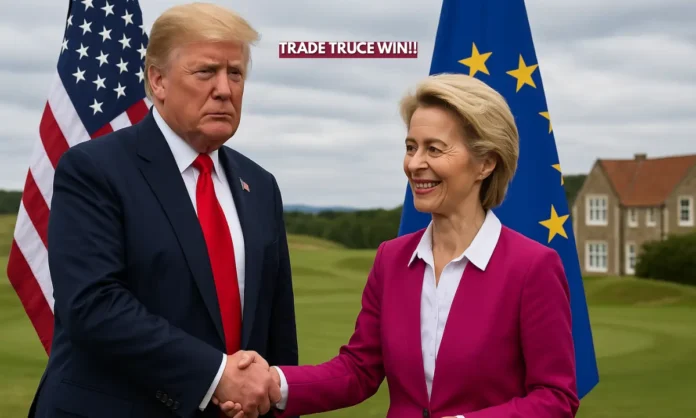Summary
- A 15% baseline tariff on EU exports to the US has replaced a threatened 30% levy.
- EU to purchase $750 billion worth of US energy and invest $600 billion additionally.
- The deal aims to stabilize a $1.9 trillion trade relationship amid global economic tensions.
Transatlantic Trade Reset: Why This Deal Matters
The United States and European Union have averted a potential trade war with what President Donald Trump called the “biggest-ever” deal, marking a pivotal moment in transatlantic economic relations. After weeks of escalating rhetoric, Trump and European Commission President Ursula von der Leyen finalized the agreement at Trump’s golf resort in Scotland, just days before Washington’s August 1 deadline for steep new tariffs on European goods.
Under the deal, a 15% baseline tariff will be levied on EU exports to the US, including automobiles, semiconductors, and pharmaceuticals—critical sectors for Europe’s economic powerhouse, Germany. In return, the EU has committed to buying $750 billion worth of US liquefied natural gas, oil, and nuclear fuels over three years, aligning with its goal of reducing dependency on Russian energy. Additionally, the EU pledged $600 billion in new investments, strengthening bilateral financial flows.
This agreement comes against the backdrop of a trade relationship valued at $1.9 trillion annually. It promises stability and predictability for businesses on both sides of the Atlantic, offering relief to industries that were bracing for higher tariffs. While welcomed as a diplomatic breakthrough, the deal has drawn criticism from European exporters who fear the 15% tariff rate remains too high compared to pre-existing levels averaging 4.8%.
Trump Strikes "Biggest-Ever" Trade Deal With European Union
— Good Luck (@DBappy55726) July 28, 2025
Full News see: https://t.co/uedXFX68DC#Songnews #USNews #Newstoday #updatenews #Newsfile #news #news10 pic.twitter.com/hnrvxUY9h0
Key Concessions and Strategic Gains
- 15% tariff applies across EU exports, including critical sectors like automobiles and pharmaceuticals.
- EU agrees to large-scale US energy imports and new investment commitments.
- Tariff exemptions secured for aircraft, certain chemicals, agricultural products, and raw materials.
For Trump, the deal reinforces his “America First” trade agenda while showcasing his ability to extract concessions from major economies. He emphasized that Europe’s commitment to purchase hundreds of billions of dollars in military equipment and energy represents a “win-win” for both sides.
Von der Leyen, on the other hand, highlighted the stability the deal brings, particularly for the EU’s auto and steel sectors, which have suffered from tariff uncertainty. While she admitted that a 15% tariff is far from ideal, she called it “the best we could get” under intense pressure from Washington. Both leaders hinted at ongoing negotiations for “zero-for-zero” agreements on strategic goods, particularly alcohol and steel, which could further ease trade tensions.
The European Reaction and Domestic Pressures
- EU exporters warn of “considerable negative repercussions,” especially in chemicals and steel.
- German industry leaders express concern despite Chancellor Friedrich Merz’s endorsement.
- Counter tariffs worth $109 billion were ready if talks had failed.
Although the agreement prevents a full-scale trade war, it has divided opinion within the EU. German industrial bodies, including the BDI and VCI, have criticized the deal for leaving tariff rates “too high,” while France and Germany pushed for additional concessions in critical sectors.
The compromise on steel remains contentious. While Trump initially ruled out any quota arrangement, von der Leyen later claimed that a quota-based system would be introduced to soften the impact of tariffs on European steelmakers. EU member states will now review and vote on the agreement, with many advocating for continued negotiations to secure better terms.
What Lies Ahead for Transatlantic Trade?
- Trump signals that further global trade negotiations will follow, calling this the “biggest of them all.”
- EU aims for additional tariff-free agreements, especially in alcohol and other consumer sectors.
- Future trade dynamics hinge on quarterly reviews and compliance with energy purchase commitments.
The deal underscores the shifting dynamics of global trade as the US continues to renegotiate its economic relationships. Trump’s aggressive tariff policies have forced the EU to diversify its trade strategy, particularly in energy, while also committing to higher defense spending under NATO—a key American demand.
Moving forward, both Washington and Brussels will need to ensure that this agreement does not merely act as a temporary truce but evolves into a sustainable framework for transatlantic trade cooperation.
Conclusion: A Fragile Victory
The US-EU trade deal marks a historic yet fragile step toward resolving escalating tariff disputes. While the 15% tariff is significantly lower than the threatened 30% rate, its long-term impact on European industries remains uncertain. For Trump, the deal cements his narrative of securing “the biggest trade agreements,” but it also puts the onus on both sides to maintain stability amid a volatile global economic climate. For the EU, the agreement buys time to protect key industries while preparing for deeper trade negotiations.


